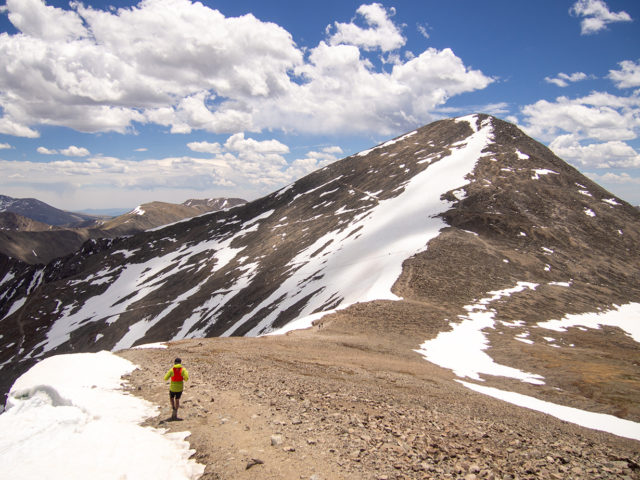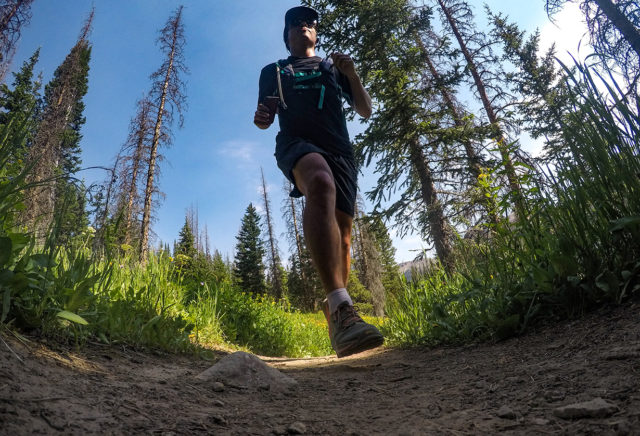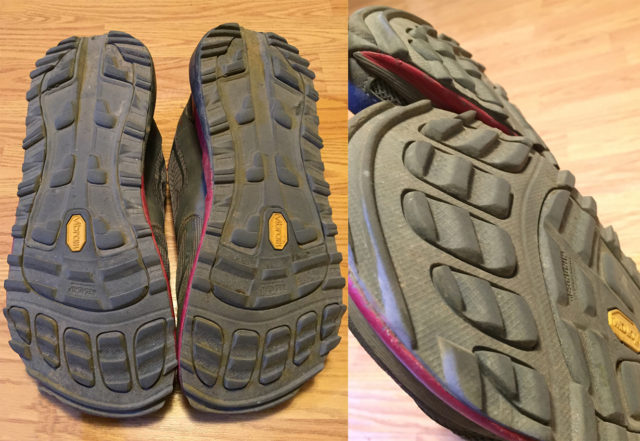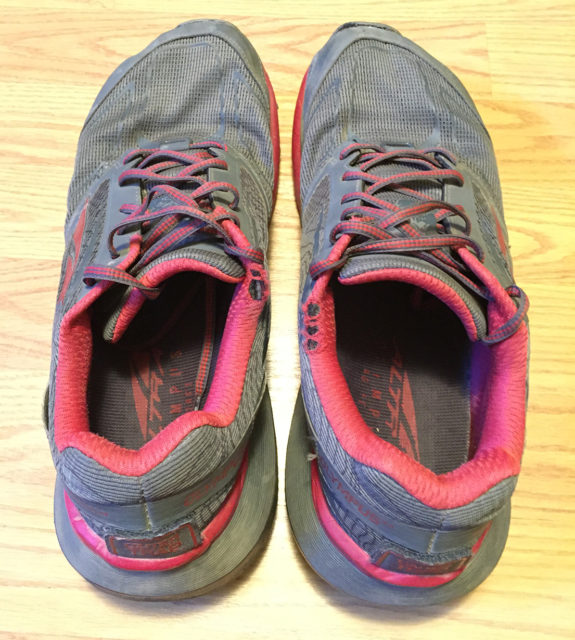Update 9.16.18
I’ve now put around 300 miles on the Olympus 3.0, and it has become my favorite shoe for the vast majority of my trail runs. As I noted in my initial review, this shoe isn’t for everyone, but I think it does what it’s designed to do very, very well. Here I’ll go into why I think the Olympus 3.0’s design makes so much sense, how it’s held up in terms of durability, and offer a more in-depth comparison to the similarly cushioned Hoka Stinson ATR 4.
Midsole and the Purpose of Highly Cushioned Shoes
Let’s start with the Olympus 3.0’s midsole. I pretty much run exclusively in shoes with high stack heights, roughly in the 25-35 mm range. And after running in several different shoes in this cushioning category (both road and trail), I’ve come to like the Olympus 3.0’s midsole even more.
Because, to me, the whole point of a shoe with a thick midsole is to soften the impact of each step. By doing so, you have to make compromises in terms of stability, efficiency, and ground feel, but many people (including me) prioritize the correspondingly forgiving ride over those other traits.
And yet, a few of the highly cushioned shoes I’ve recently been running in don’t really soften each step very much. The Altra Duo, for example, is a road shoe with a 30 mm stack height that has an extremely firm midsole. It is consequentially far more efficient than softer shoes like the Olympus 3.0, but the result is a harsher and far less plush ride.

Similarly, the Hoka Stinson ATR 4 is a road-to-trail shoe with a 32 mm stack height that feels much firmer than the Olympus 3.0. The Stinson ATR 4 does mute out any sort debris on the trail, but it does not feel very plush or soft.
To make a mountain-biking analogy, running in the Stinson ATR 4 seems like riding a downhill bike with a ton of travel, but then locking out the suspension so it doesn’t “give” much at all. It just doesn’t seem to make sense to me. If you’re not getting that cushy feel, why not just go with a lower stack height and get better stability?
Of course, there’s a tradeoff in efficiency with softer, plusher shoes like the Olympus 3.0. You lose a bit more energy each time you sink into the shoe’s midsole. So if you specifically want a high-stack-height shoe that is pretty efficient for its size, then the Stinson ATR 4 could be the better choice for you.
But if you’re considering a highly cushioned shoe because you’re looking for that softer, more forgiving ride, then I think the Olympus 3.0 is an excellent option. You’ll lose some efficiency compared to firmer or dramatically less-cushioned shoes, but in exchange, you get less stress on your joints and feet.
Altra Olympus 3.0 vs. Hoka Stinson ATR 4
I already went into the differences between these two shoes’ midsoles, but there are a few other things I’ve noticed as I’ve spent more time running in these two maximalist shoes.
Let’s first talk about stability. The narrower, lower-volume fit of the Stinson ATR 4 does make it feel a bit more secure when running on fairly low-angle, off-camber terrain (e.g., flat singletrack with lots of rocks or roots). To be clear, neither of these shoes is very stable compared to the whole trail shoe spectrum. If you prioritize stability, you should be looking at shoes with lower stack heights.

But while the Stinson ATR 4 feels a bit more confidence-inspiring on flatter terrain, I actually prefer the Olympus 3.0 when the trail heads downhill. As I noted in my review of the Stinson ATR 4, that shoe’s rockered sole profile can make it feel like it wants to go faster than I do on steep downhills. It just wants to keep rolling. The Olympus 3.0’s flatter profile lets me engage the breaking lugs and slow myself down when I want to.
The upside to the Stinson ATR 4’s rockered sole is that, when combined with its firmer midsole, it makes the Stinson ATR 4 noticeably more efficient on flat terrain, whether that’s on a trail or a road. And that takes us to the next section…
Olympus 3.0 as a Road-to-Trail Shoe
We received a question from a reader about using the Olympus 3.0 for runs that consist of both pavement and trails, so I wanted to go into a bit more detail on that now that I’ve spent more time in the Olympus 3.0 on pavement. I think the Olympus 3.0 can definitely work for this, though it again depends on your priorities and what your typical runs consist of.
Compared to highly-cushioned dedicated road shoes like the Altra Duo and Hoka Clifton 5, the Olympus 3.0 definitely gives up some efficiency. It’s noticeably more plush and springy than those shoes, but the Olympus 3.0 does not feel as fast. And as I just touched on, the Olympus 3.0 feels a bit less efficient compared to the Hoka Stinson ATR 4, which Hoka labels as a road-to-trail shoe.
So again, if you’re primarily looking for a plush ride and don’t need the most efficient max-cushioned shoe, the Olympus 3.0 could function as shoe for both the road and trail. I think it functions best as a trail shoe since that’s where it’s grippy outsole is best utilized, but I’ve still happily used it for some casual runs on pavement.
Durability
After ~300 miles, the Olympus 3.0 is in very good shape overall. I haven’t noticed any significant “packing out” of its midsole, which is always a worry for me when it comes to cushy shoes.
The Olympus 3.0’s outsole is in excellent shape considering the mileage. I haven’t torn off any lugs, and the rubber hasn’t worn down very much. This is actually pretty surprising since I’ve spent most of my time running on rocky trails and probably around 75 miles of pavement. Given how grippy the Olympus 3.0’s Vibram MegaGrip outsole has been, I’m really impressed by its durability.

The only real durability issue I’ve noticed with the Olympus 3.0 is the collar lining on the medial side. The red lining fabric has torn near the last lace eyelet on both shoes. I’ve never noticed this while running, but it’s something that has not happened on any of my other shoes.

Bottom Line
After putting more time on it, I still think the Altra Olympus 3.0 is an excellent maximalist trail shoe. It’s not the most efficient highly cushioned shoe, and it’s not the most stable. But if you’re looking for a trail shoe that offers a plush, springy ride, grips very well on most surfaces, and can handle some miles on pavement, I highly recommend the Olympus 3.0.

Hi Luke,
Thanks for the excellent review, one question remains for me; would you reccomend the [Olympus as a road-to trail shoe?
Were i live my training route is about 15 k, from asphalt (3 k), to forest(7 k), to sand (2k) and another 3 k asphalt back.
I have bunions(so yes, Altra plz) and love full cushioning, but as sais before would you reccomend the Olympus as combi shoe trail/road?
Thanks in advance!
Arne Kleefman,Leusden,NL
Hi Arne,
I’d echo Marc’s comment below re: his experience with the Olympus 2.0. I think the Olympus 3.0 works just fine as a road-to-trail shoe. The lugs on its outsole aren’t enormous, and I never thought it felt wildly out of place while doing short runs on paved roads.
I think the main things to consider will be the potentially faster wear on the sole and the slightly decreased efficiency due to the larger lugs (and for what it’s worth, I didn’t really notice the Olympus 3.0’s outsole on pavement, but people coming from firmer, dedicated-road shoes might).
But especially for runs where you’re only doing around 6-10km of running on asphalt, I think the Olympus 3.0 would be a great road-to-trail option.
– Luke
Hi Marc and Luke,
Thanks alot for your answer and comment, will buy the Olympus 3.0 now:)
Me too :)
Cu soon in NL:P
Hi, I would like to reply to Arne.
I have the Olympus 2.0 , same outsole and I have ran a half marathon on tarmac with them without any issues. And used them for road2trail also, 3k is no problem. Just my opinion.
Marc
Hey Luke,
Any updates on the durability of the outer? How many miles have you put on them so far and how are they holding up? I had the 2.0 and the outer around the pinky toe blew out. Not as bad as my lone peak 2.5s did though.
Hi Tim,
I’ll post a long-term update near the end of this summer, but after around 125 miles, I still haven’t had any major issues. The pinky-toe area of the Olympus 3.0 is reinforced, so that might help prevent that issue, but I’ll report back with a full update in a couple months once I’ve put more miles in them.
Cheers,
Luke
Good to know. 125 is a good amount of miles to know how they’ll hold up. Thanks for responding. Think I’m going to make the plunge. Just about got 400mi on my Timps.
Do you recommend this for long walking on concrete + some light trail? I am doing the Camino de Santiago again next year and I’d like something that can do mostly towns, concrete and then some mountain trails (very easy to moderate), around 16-20miles a day. Would love something that didn’t look too “outdoorsy” too :-) Thanks for the excellent reviews!
I think the Olympus could work pretty well for what you’re describing. That said, there are a couple things to keep in mind.
First, the Olympus’ sticky rubber outsole might be overkill if you’re mostly walking on concrete. But if you don’t mind a bit of extra grip (or prefer it), then that wouldn’t be an issue.
The second thing is the flexibility of the Olympus. Many traditional hiking shoes / boots employ some sort of shank or stiffer (often PU) material in the sole to keep them from flexing as much as running shoes like the Olympus, which uses a softer foam midsole. Many people like the stiffer, more supportive feel of dedicated hiking shoes / boots for really long treks or when carrying a lot of weight on their back since the stiffer midsole offers a more stable feel. But if you’re not carrying a lot of weight and / or have done similarly long walks with other running shoes, then I again think the Olympus could work.
Of the running shoes I’ve used, the Olympus is one of my favorites for longer hikes where I’m not carrying a heavy pack.
Thank you Luke! Is there a different shoe you’d recommend for this use case- especially if I would be carrying a ~ 20lb pack?
There are a ton of options out there and a lot of this depends on fit, so my recommendation would be to go to a trusted outdoor shop and work with their staff to figure out the best option for you. They should have many products to choose from and if you fill in the staff on what your trip is, what your needs are, etc., I think they should be able to provide a better recommendation than I can since they can actually have you try on several different pairs of shoes.
Excellent point.. That way I can buy local as well. Thanks for the excellent blog.
What a nice review, thanks a lot for putting this out .
I tried the Hoka Evo mafate but it’s too narrow for me and I’m looking for wide and plushy shoe for 100 + events , I think I’ll try altra Olympus !
Do you recommend this shoes for over pronating runners?
The Olympus is definitely wider than the Evo Mafate, so I think it’d certainly be worth trying on.
As for your question about pronation, I think this would be best answered by an experienced running shop employee and / or running technique specialist (it’s hard for me to answer without seeing you run, how the shoe fits your foot, etc.). The Olympus doesn’t offer a exceptional support due to its more flexible midsole, so it wouldn’t be my top recommendation if you’re specifically looking for a shoe that will compensate for pronation. But I’d try and find a store that stocks it, try on the shoe, and see if the staff can provide any input.
My comparison. Hoka Stinson vs. Altra Olympus. The Stinson is slightly stiffer a little hard to push of the toes than the Hoka. Also the Hoka traction on climbs is so that u can’t push hard, it’s a little wasted effort because of lack of traction. Cusion seems to be compatible possibly. I noticed brand new Olympus offer more cushion than my Hoka with 200 miles. Not fair comparison. The Hoka is more stable, so there u have it. My Hoka with 200 miles have some wear in the bottom, but the uppers look like new. I washed several times in washer. Both shoes offer wet feet if you are near any moisture what so ever.
I love my Olympus 2.5 for long non-technical runs. However, their biggest shortcoming is their very poor drainage after water crossings. I ran big blisters in them last year in my first 100k and have been looking for an alternative ever since, with no success. How do the 3.0 hold up in wet conditions?
Hmm, I don’t think the Olympus 3.0 would really solve that issue. It drains OK, but it doesn’t have a lot of open spaces in the upper to let water out of, so I’d say it’s still on the lower end of the spectrum when it comes to drainage of water.
I have gone through 2 pairs. Both with 1000km on each. Only as a road shoe.
Hokas keep changing the styles so have stuck with Altra Olympus 3s because of the fit.
I run 100milers on the road and haven’t had any issues.
The lugs last and I do have the same wear on the inside collar. But marginal.
The only draw back as using them as a road shoe, is they are noisy. Takes about 250km to break them in.
I’m impressed.
About to buy my 3rd pair.
I have tried the Torin road ones but they wore down in 300km.
The Olympus sole must be harder wearing.
Hi Luke,
Im wearing Altra TIMP US SIZE 10, feel a bit too roomy for me. To purchase Altra Olympus 3, do you advise to take size 9.5 US men , or just the same size?
Hmm, that’s tough. I got along well with the Olympus and Timp in the same size (my standard running shoe size), but the Olympus is a bit higher volume overall compared to the Timp, so it might work to size down a half size. The only thing I’d be worried about is the overall length, which could be short. But if you’ve run in size 9.5 shoes in the past, then the 9.5 Olympus should work (it runs pretty true to its size).